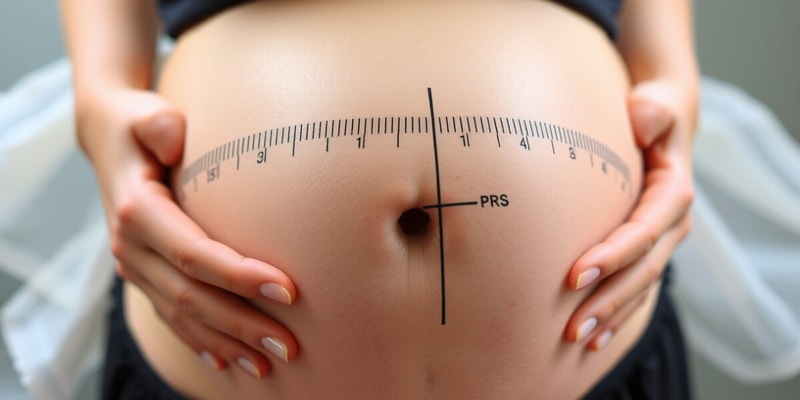Podcast Beta
Questions and Answers
What indicates a negative station in fetal positioning?
Which fetal lie is considered compatible with a natural vaginal birth?
At what dilation does the active phase of labor begin?
What is the maximum duration for a single uterine contraction to avoid complications?
Signup and view all the answers
How often should contractions occur during the transition phase of labor?
Signup and view all the answers
What complication is indicated by LOP and ROP fetal positions?
Signup and view all the answers
Which contraction frequency indicates the latent phase of labor?
Signup and view all the answers
Which option describes how to measure contraction intensity accurately?
Signup and view all the answers
Which statement is true regarding the stages of labor?
Signup and view all the answers
What signifies engagement in fetal positioning?
Signup and view all the answers
What is considered a normal hemoglobin level for females during pregnancy?
Signup and view all the answers
At what point during pregnancy can hemoglobin fall to 10 and still be considered normal?
Signup and view all the answers
Which of the following symptoms is NOT typically associated with the 2nd trimester of pregnancy?
Signup and view all the answers
What is an effective treatment for morning sickness during the first trimester?
Signup and view all the answers
How should a pregnant woman position herself to alleviate dyspnea during the 2nd and 3rd trimester?
Signup and view all the answers
During which trimesters is urinary incontinence commonly experienced?
Signup and view all the answers
What is the correct dilation of the cervix in centimeters when fully dilated?
Signup and view all the answers
What is the term for the thinning of the cervix during labor?
Signup and view all the answers
What strategy is recommended to manage back pain during the 2nd and 3rd trimester?
Signup and view all the answers
Which of these statements regarding pregnancy is true?
Signup and view all the answers
How is the ideal weight gain during pregnancy calculated based on the week of gestation?
Signup and view all the answers
At what week can the fundus typically be palpated for the first time?
Signup and view all the answers
What signifies the rapid initial weight gain that might indicate a possible complication during the first trimester?
Signup and view all the answers
Which of the following is a positive sign of pregnancy?
Signup and view all the answers
What is the proper schedule for patient visits in the third trimester of pregnancy?
Signup and view all the answers
When should the first auscultation of the fetal heartbeat ideally occur?
Signup and view all the answers
What is the primary purpose of using the knee-chest position during delivery?
Signup and view all the answers
Which of the following is NOT considered a probable sign of pregnancy?
Signup and view all the answers
What is the first action to take if a prolapsed cord is identified during delivery?
Signup and view all the answers
What is Chadwick's sign indicative of during pregnancy?
Signup and view all the answers
What does the acronym LION stand for in management of birth complications?
Signup and view all the answers
What weight gain is typical for the second trimester per week?
Signup and view all the answers
When is quickening most likely to be felt by the mother?
Signup and view all the answers
In what scenario is it safe to administer systemic pain medication to a woman in labor?
Signup and view all the answers
Why is it essential to stop Pitocin immediately in a crisis during labor?
Signup and view all the answers
Which of the following conditions requires immediate notification of the doctor in a laboring patient?
Signup and view all the answers
What is the recommended intervention if a multigravida patient at 8 cm dilation requests IM pain medication?
Signup and view all the answers
What position should a laboring mother be placed in if LION is initiated?
Signup and view all the answers
What are the potential consequences of administering systemic pain medication just before delivery?
Signup and view all the answers
What is the appropriate measure to take when assisting a woman in labor experiencing back pain?
Signup and view all the answers
Study Notes
Maternity Care Overview
-
Due Date Calculation (Nagele’s Rule):
- Start with the first day of the last menstrual cycle, add 7 days, subtract 3 months, and add a year.
-
Weight Gain During Pregnancy:
- Recommended total gain is 25-31 pounds.
- Ideal weight gain formula: [Week of gestation] - 9 (+ a couple lbs).
- If weight gain exceeds 3 lbs in a month, further assessment is needed.
-
Fundus Development:
- Fundus of the uterus is not palpable until week 12.
- Reaches umbilical level between weeks 20-22.
- 1st trimester: 1 lb/month (total of 3 lbs). Fundus is not palpable.
- 2nd trimester: 1 lb/week; fundus at umbilicus by week 20-22.
- 3rd trimester: 1 lb/week; fundus above umbilicus, priority shifts to baby.
Pregnancy Signs
-
Positive Signs:
- Fetal skeleton via X-ray, ultrasound presence, fetal heart auscultation, and examiner palpation of fetal movement.
- Fetal heartbeat detected by 5 weeks, audible between 8-12 weeks.
- Quickening (first fetal movements) occurs around 16-20 weeks.
-
Probable/Presumptive Signs ("The Maybes"):
- Positive pregnancy test and physical signs such as Chadwick's, Goodell's, and Hegar's signs:
- Chadwick: Cervical cyanosis.
- Goodell: Cervical softening.
- Hegar: Uterine softening.
- Positive pregnancy test and physical signs such as Chadwick's, Goodell's, and Hegar's signs:
Patient Care and Teaching
-
Appointment Schedule:
- Monthly visits until week 28, then bi-weekly until week 36, and weekly until delivery.
-
Hemoglobin Levels:
- Normal range for females: 12-16.
- 1st trimester normal to drop to 11, 2nd can drop to 10.5, and 3rd can drop to 10, with acceptable low being 9.
-
Common Symptoms:
- Morning sickness: usually in the first trimester; treat with dry carbs while in bed.
- Urinary incontinence: occurs in the first and third trimesters; void every 2 hours.
- Dyspnea and back pain common during 2nd and 3rd trimesters; treat with tripod position and pelvic tilts, respectively.
Labor and Birth Essentials
-
Labor Initiation:
- Regular, progressive contractions signal onset.
-
Cervical Changes:
- Dilation: 0 cm (closed) to 10 cm (fully dilated).
- Effacement: Cervical thinning from thick to 100%.
-
Fetal Positioning:
- Station indicates fetal head's position in relation to ischial spine, negative (-1, -2) is undesirable, positive (+1, +2) is favorable.
- Vertex lie is ideal for vaginal birth, while transverse lie indicates complications.
Stages of Labor
-
Stage One Overview:
- Phase 1 (Latent): Dilation 0-4 cm, contractions mild and 5-30 minutes apart.
- Phase 2 (Active): Dilation 5-7 cm, moderate contractions 3-5 minutes apart.
- Phase 3 (Transition): Dilation 8-10 cm, strong contractions 2-3 minutes apart.
-
Contraction Timing:
- Frequency: Time between consecutive contractions.
- Duration: Length of a single contraction from start to finish.
- Intensity: Strength measured by palpation.
Complications and Pain Management
-
Complications:
- Back labor due to fetal positioning (LOP, ROP): Treat with knee-chest position and counterpressure on the sacrum.
- Prolapsed cord: Emergency requiring immediate repositioning and maintaining head pressure.
- General interventions: Employ LION approach (Left side, IV increase, O2, Notify doctor) if complications arise.
-
Pain Management:
- Avoid systemic pain medications if delivery is imminent to prevent adverse effects on the baby.
- Assess likelihood of delivery within the timeframe of medication peak action before administration.
Studying That Suits You
Use AI to generate personalized quizzes and flashcards to suit your learning preferences.
Related Documents
Description
This quiz covers key concepts related to maternity, specifically calculating due dates using Nagele’s Rule, understanding weight gain during pregnancy, and the anatomy of the fundus. Test your knowledge on important milestones and health assessments in pregnancy.





